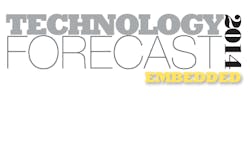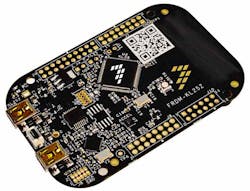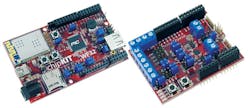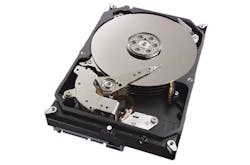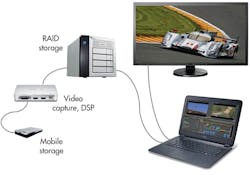Embedded electronics are becoming more pervasive, more connected, and more personal, from the ubiquitous smart phone to emerging telepresence robotic devices like the Suitable Robotics Beam and Double Robotics Double (Fig. 1). In fact, these robotic platforms are being used in schools, hospitals, and other environments. And like unmanned aerial vehicles (UAVs), they are moving into the public’s consciousness.
Related Articles
- Heterogeneous System Architecture Changes CPU/GPU Software
- Consumer Electronics Take User Interfaces Beyond Your Fingertips
- The Internet Of Thingamajigs
- Battle Of The Supercomputing Nodes
- Memory Channel Storage Puts SSD Next To CPU
Telepresence robots are emblematic of the changing ways users are interfacing with embedded electronics. Overall, user interaction and user interfaces are going to change this year. Multitouch interfaces are becoming more accurate and less expensive, so expect them to appear everywhere. Non-touch 3D interfaces also are now available and being incorporated into more than gaming platforms (see “3D Video Sensors Improve User Interactivity” at electronicdesign.com).
3D printers are revolutionizing prototyping. 3D sensors and scanners are making this prototyping easier too (see “Matterform Interview–Low-Cost 3D Scanner” at electronicdesign.com). These printers and scanners are becoming more common, more functional, and easier to use.
This file type includes high resolution graphics and schematics when applicable.
More Clouds
The Internet connects people and all of these embedded devices together. Telepresence robots depend on the Internet to link to their remote masters. Browsers and apps provide ways to find out about and buy more of these products online. However, this year is really about the Internet of Things (IoT). Machine-to-machine (M2M) connectivity has been around for decades, but the scope, flexibility, and cooperative interaction between devices will change radically as the year progresses (see “The Internet Of Thingamajigs” at www.electronicdesign.com).
Expect massive cloud services like those from Amazon and Verizon to grow. Anyone can use the cloud to access supercomputing power, so startups will grow rapidly based on demand without any major capital investment. As demand for mobile devices and applications continues to accelerate, supporting server services will find homes in the cloud.
Development tools are quickly moving to the cloud. Team collaboration techniques like bug tracking and source code management were around even before the Internet. But these days, big jobs like system-on-chip (SoC) verification are being completed in the cloud. Microsoft Visual Studio and other platforms are moving more functionality to the cloud as well (see “A Look At Visual Studio 2013” at electronicdesign.com).
Open-source development environments like mbed are specifically designed to operate online, giving developers preconfigured access to the latest compilers and tools. This approach has been heavily utilized in app development for smart phones and tablets. The development tools, delivery, deployment, and billing tools are all integrated. Developers often only need a Web browser to create and manage these apps.
Look for more of this in the future since it locks in developers and allows detailed tracking of their actions. Also, keep an eye out for security issues in these types of environments and within applications being developed. Connectivity and common platforms are speeding development, but they open up vectors of attack and tracking issues. Edward Snowden’s revelations show that even innocuous devices like smart phones can be the target of criminals and the National Security Agency alike. On the plus side, it will be easier to talk to vendors about security since it is more than a checklist item these days.
More Boards And Modules
Online development communities and tools have grown up around module platforms like Arduino and Raspberry Pi (see “Arduino, Raspberry Pi or BeagleBone?” on electronicdesign.com). They will become even more important this year as more vendors adopt these form factors for development platforms. For example, Freescale’s Freedom FRDM-KL25Z (Fig. 2) supports the mbed cloud development environment while utilizing the Arduino expansion board form factor (see “New Dev Tools, Cloud Software Added To Arduino Ecosystem” on electronicdesign.com).Microchip has expanded its Arduino compatible chipKIT ecosystem with two development tools from Diligent Inc. and an embedded cloud-software network (Fig. 3). Diligent’s chipKIT WF32 board reduces the need to purchase additional hardware or shields by integrating Microchip’s 32-bit PIC32MX695F512L MCU, its MRF24WG0MA Wi-Fi module, and a switch-mode power supply that uses the company’s MCP16301 dc-dc converter, along with a MicroSD card.
With Diligent’s chipKIT Motor Control Shield, applications can be developed using various motor types, such as servos and steppers, while enabling users to exploit extra I/O pins found on chipKIT development boards to enhance connectivity. The embedded cloud software framework facilitates the creation of Internet of Things applications with the WF32.
Diligent helps speed the development of wireless HTTP server applications with its comprehensive sample application, which supports static pages loaded from the WF32’s MicroSD card, as well as dynamically generated Web pages. The WF32 offers a rapid method for evaluating Wi-Fi in embedded designs and for creating embedded cloud-computing services using Exosite.
Furthermore, look to modules to quickly deliver solutions with highly integrated SoCs with wireless communication services. Peripheral connections are easy to design compared to SoC support. This is especially true for FPGAs like Xilinx’s Zynq, which incorporates dual Cortex-A9 cores. Also, check out the ever-shrinking form factor standards like the micro Qseven and the Type 6 COM Express Mini.
Board form factors like PC/104, VME, and CompactPCI have not disappeared and still command a major portion of the market compared to their newer, faster counterparts. Most new designs use boards with high-speed serial interfaces, though, especially platforms from the mid-range to the high end of the computational spectrum, because their processors use PCI Express. Matching chipsets are often utilized to deliver interfaces like PCI for legacy environments.
Still, the trend continues toward high-speed serial interfaces with legacy peripheral connections disappearing. Motherboards will have USB 3.0 and HDMI, but PS/2 keyboard and mouse ports are long gone. Even VGA connectors will be hard to find, and forget about integrated device environment (IDE) interfaces for most platforms.
More Servers, Connectivity, And Storage
Cloud servers have been racks of 1U servers as well as blade-based systems. But very large clouds have moved to even more specialized designs that are far from anything that will reside outside of large enterprise environments. Platforms like AMD’s SeaMicro and HP’s Moonshot pack hundreds of cores into a rack with high-speed interconnects (Fig. 4). The 64-bit Arm processors also will appear in this space in 2014, which should make things very interesting.
Platforms like Intel’s C2000 eight-core Atom target the growing microserver market. It is also finding a home in this type of cluster environment. The original SeaMicro rack was filled with dual core Atoms.
These multicore systems are tackling computational chores, but they also will be used for software defined networking (SDN) and network function virtualization (NFV), bringing communication closer to the computational and storage side of things. Intel’s latest “Coleto Creek” chipsets for its Xeon E5-2600 processors accelerate network cryptography and compression chores. They have improved virtualization support as well, which is key to partitioned clouds. While workstations are slogging it out with 1-Gigabit Ethernet, servers are handling 40-Gigabit and 100-Gigabit Ethernet ports. At least 100-Gigabit Ethernet seems to be it for the near future.
Storage will be more active, with 12-Gbit/s SAS drives and controllers available in 2014 in time to handle the coming flood of flash drives. They also will compete with direct connect storage via PCI Express in the form of NVM Express. Even closer to the processor cores will be technology like Diablo Technologies’ Memory Storage Channel dual-inline memory module (DIMM), which plugs into a DDR3 socket. The tradeoff will be in DIMM socket usage because there is an insatiable appetite for DRAM as well.
Flash storage will see challenges in the range of available options including tradeoffs in lifetime versus density with multi-level cell (MLC) and triple-level cell (TLC) NAND flash being used in the enterprise. Yet there is likely to be more innovation in storage at a higher level this year. For example, Seagate’s Kinetic hard drives sport a pair of Ethernet interfaces and provide an object-level communication protocol versus the low-level, block-oriented protocol of SATA and SAS (Fig. 5).
More Resolution
Storage isn’t the only place were radical change is occurring. Displays are moving to 4K, just in case you haven’t been to the electronics store lately. Those 4K Ultra HDTVs are chock full of FPGAs handling up-conversion, because for now HD content is all there is. They will be ideal for gaming, digital signage, and other generated content. HD content will look better on those large-screen 4K HDTVs.
High-resolution displays were available before the advent of 4K displays, but they will now be more common and much cheaper. The 2014 Consumer Electronics Show will have as many new 4K monitors as Ultra HDTVs. The standards have been updated to support these new displays, including HDMI and DisplayPort.
Intel’s Thunderbolt 2 hardware interface is designed to deliver 4K video. It combines the two previously independent 10-Gbit/s channels into one 20-Gbit/s bi-directional channel that supports data and/or display. It requires an active cable as well. Users will be able to create, edit, and view live 4K video streams delivered from a computer to a monitor over a single cable while backing up the same file on an external drive or series of drives simultaneously along the same device daisy chain (Fig. 6). Quite a few optical cables will be available in lengths up to 100 meters, allowing for interesting placement of displays and computers.
More Software
Vendors started back in pre-history (at least from an Internet perspective) with free reference designs. This moved to free compilers and then full integrated development environments (IDEs). Now these software suites are being bundled with operating systems, libraries, and even Web-based development frameworks.
Texas Instruments’ tool suite for some platforms comes with a real-time operating system (RTOS). Freescale is bundling the MQX Lite RTOS with its tools for some chips as well. Microchip’s MPLAB Harmony framework even integrates third-party software licensing. These features reduce time-to-market so hardware vendors can sell more chips.
This year will be the first time developers have access to AMD’s Accelerated Processing Unit (APU) processors, which employ its Heterogeneous System Architecture (HSA). The HSA integrates the virtual memory address for CPU and GPU cores. AMD HSA CPUs are found inside the new Sony PlayStation 4 and Microsoft XBox One game consoles.
These platforms are the only ones available so far, but Arm is part of the HSA Foundation and HSA is platform agnostic. That should make things interesting in the future. HSA operating system and compiler support started with Linux, and it supports Microsoft’s C++ AMP. Oracle’s Java works with HSA and will have native support via Project Sumatra in Java 8.
“Big Data” parallel programming tools are moving down into the traditional embedded space, as these platforms sport dozens or hundreds of cores. Uploading data to the cloud is one way to implement the IoT, but there are times that local clouds may be more applicable.
There continues to be a trend of using more scripting languages like JavaScript or Lua on lower-end embedded platforms. IoT is driving some of this since it provides a way to run applications within a sandbox.
Whoever said embedded development was easy never had so many tradeoffs to deal with.
About the Author
William G. Wong
Senior Content Director - Electronic Design and Microwaves & RF
I am Editor of Electronic Design focusing on embedded, software, and systems. As Senior Content Director, I also manage Microwaves & RF and I work with a great team of editors to provide engineers, programmers, developers and technical managers with interesting and useful articles and videos on a regular basis. Check out our free newsletters to see the latest content.
You can send press releases for new products for possible coverage on the website. I am also interested in receiving contributed articles for publishing on our website. Use our template and send to me along with a signed release form.
Check out my blog, AltEmbedded on Electronic Design, as well as his latest articles on this site that are listed below.
You can visit my social media via these links:
- AltEmbedded on Electronic Design
- Bill Wong on Facebook
- @AltEmbedded on Twitter
- Bill Wong on LinkedIn
I earned a Bachelor of Electrical Engineering at the Georgia Institute of Technology and a Masters in Computer Science from Rutgers University. I still do a bit of programming using everything from C and C++ to Rust and Ada/SPARK. I do a bit of PHP programming for Drupal websites. I have posted a few Drupal modules.
I still get a hand on software and electronic hardware. Some of this can be found on our Kit Close-Up video series. You can also see me on many of our TechXchange Talk videos. I am interested in a range of projects from robotics to artificial intelligence.
